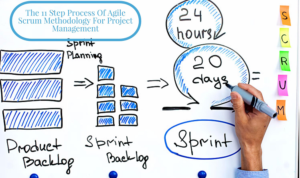Scrum
Scrum is one of the most popular frameworks for implementing agile. So popular, in fact, that many people think scrum and agile are the same thing. (They’re not.) Many frameworks can be used to implement agile, such as kanban for example, but the scrum has a unique flavour because of the commitment to short iterations of work.
What is so special about scrum?
With scrum, the product is built in a series of fixed-length iterations called sprints that give teams a framework for shipping software on a regular cadence. Milestones–i.e., the end of a sprint–come frequently, bringing with them a feeling of tangible progress with each cycle that focuses and energizes everyone. (“Continuous inspiration” for the win!) Short iterations also reinforce the importance of good estimation and fast feedback from tests–both recurring struggles in waterfall projects.
Scrum calls for four ceremonies that bring structure to each sprint:
Sprint planning: A team planning meeting that determines what to complete in the coming sprint.
Daily stand-up: Also known as a daily scrum, a 15-minute mini-meeting for the software team to sync.
Sprint demo: A sharing meeting where the team shows what they’ve shipped in that sprint.
Sprint retrospective: A review of what did and didn’t go well with actions to make the next sprint better.
The essential roles for scrum success
- The Product Owner
- The Scrum Master
- The Scrum Team
We are conveniently located to provide Scrum Training in Brampton, Mississauga, Toronto, and Scarborough area.
We offer the following SCRUM training courses at different locations in Brampton, Mississauga, Toronto and Scarborough



